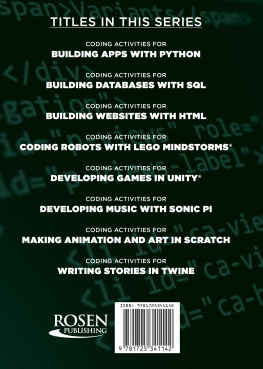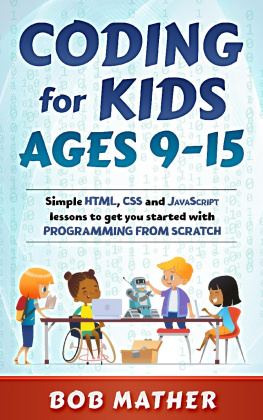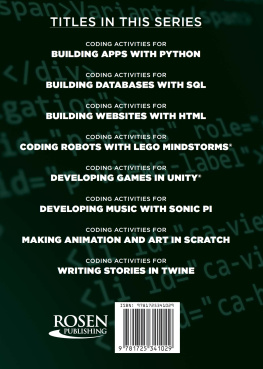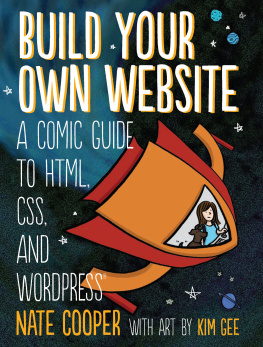
Published in 2022 by The Rosen Publishing Group, Inc.
29 East 21st Street, New York, NY 10010
Copyright 2022 by The Rosen Publishing Group, Inc.
First Edition
All rights reserved. No part of this book may be reproduced in any form without permission in writing from the publisher, except by a reviewer.
Library of Congress Cataloging-in-Publication Data
Names: Furgang, Adam, author.
Title: Coding activities for building websites with HTML / Adam Furgang.
Description: First edition. | New York, NY: The Rosen Publishing Group, Inc., 2022. | Series: Code creator | Includes bibliographical references and index. | Audience: Grades 712.
Identifiers: LCCN 2019014622| ISBN 9781725341142 (library bound) | ISBN 9781725341135 (pbk.)
Subjects: LCSH: HTML (Document markup language)Juvenile literature. | Web sitesDesignJuvenile literature.
Classification: LCC QA76.76.H94 F875 2022 | DDC 006.7/4dc23
LC record available at https://lccn.loc.gov/2019014622
Manufactured in the United States of America
Some of the images in this book illustrate individuals who are models. The depictions do not imply actual situations or events.
CPSIA Compliance Information: Batch #CSRYA22. For further information contact Rosen Publishing, New York, New York at 1-800-237-9932.

Contents
Introduction
Creating a website with HTML may seem commonplace today, but the truth is that the technology required to create and share a websiteor even go online and browse the internethas not been around for a very long time. The invention of the internet, which allows different types of computers to network so they can communicate with one another, was a feat accomplished by many people over the course of many decades.
The process that led to the World Wide Web and the internet was not a direct or always-obvious path, but it was an important one.
The first computers invented were mechanical, not electronic. These mechanical computers were devices created to help people accomplish calculating tasks more quickly. In 1890, an inventor named Herman Hollerith created a machine to help calculate the results from the United States census. At the time, calculating the census was a task that took years to finishobviously not an efficient use of the governments time. Holleriths new machine used a punch card system and completed the complex task in only a few months. His invention also saved the government a substantial amount of moneyand foreshadowed the future importance of computing devices. In 1896, Hollerith founded the Tabulating Machine Company. Eventually, this became the International Business Machines Corporation, which is today known as the computer company IBM.
In 1939, a British mathematician named Alan Turing was instrumental in another important milestone in the history of computers. During World War II, Turing was working with the British government as a code breaker to help decrypt Nazi transmissions that were sent in encrypted code. A German machinecalled Enigma because it was used to create nearly unbreakable encryptionscreated the codes used to hide messages. At the time, the codes created by the Enigma machine were ironclad; no code breakers had been able to develop a consistent method through which they could decrypt these messages and gain valuable intelligence about Germanys plans. Turing, working alongside other code breakers in a group called Ultra, created an electromechanical machine called the Bombe, which was able to decrypt the secret German Enigma codes and greatly aid British and American war efforts. This machine far more advanced than Holleriths earlier devicewas massive, containing 10 miles (16 kilometers) of tightly wound wire.

During World War II British computer scientist Alan Turing helped to create the Bombe, a device that was able to decipher German Enigma encrypted code signals.
In 1958, Jack Kilby and Robert Noyce separately invented the integrated circuit, which was also known as the microchip. This invention eliminated the need for large vacuum tubes and larger circuits, and allowed computers to become significantly smaller while maintaining their computing power. The handheld computer devices that are common today would not have been possible were it not for the invention of the microchip.
Another big step toward bringing computers into homes came when friends Steve Jobs and Steve Wozniak famously started Apple Computers in Jobss parents garage in Los Altos, California. They formed their company on April 1, 1976. Their first microcomputer kit was called the Apple I. The consumer-grade Apple II was released in 1977 and quickly became the most successful personal computer at the time. In 1984, Apple announced the Macintosh, one of the first home computers with a graphical user interface, or GUI. After the far-reaching success of some of its earliest products, Apple became a public company on September 7, 1984. The Macintosh Plus was released in 1986, by which time Apple had become a symbol for innovation and cutting-edge technology across the globe. In the decades that followed the companys early success, home computers became more affordable, more powerful, andof coursevery popular.
While computer hardware was becoming more advanced and moving from professional to personal use, networking was still in its early days. Before the rise of the internet as it is known today, there was a computer network called the ARPANET (Advanced Research Projects Agency Network). The network began as a government experiment to link computers together over telephone lines so they could share information with one another. The US military also wanted a network with no centralized core or headquarters that could be eliminated by an enemy attack.

Steve Jobs (left) and Steve Wozniak co-founded Apple Computers in 1976. Apple eventually became a leading manufacturer of personal computers and mobile devices.
In 1989, computer scientist Tim Berners-Leenow a legendary figureinvented the World Wide Web while working at the European Organization for Nuclear Research (CERN). The World Wide Web is an information-retrieval system that allows storing, sharing, and retrieving computer information. Berners-Lee also devised a way of linking information; this method was called hypertext, or, more common today, hyperlinks. In addition to this, he developed a computer language called HTML, or hypertext markup language, for formatting graphics, information, and text shared on display screens between computers. After Berners-Lee and others set the standards for the internet, more and more home computers were manufactured to connect and communicate with one another using the methods he devised.

Tim Berners-Lee is one inventor of the World Wide Web. He is still involved with his creation and is shown here at the Web Summit 2018 in Lisbon, Portugal.
HTML is one of the most successful and enduring computer languages of all time; it is still widely used in web design decades after its creation. It will be the basis for these activities, as well. Learning a computer language like HTML is challenging, but it is also exciting. The following activities are designed to help you grasp how the HTML computer language is responsible for the visual organization of text, fonts, colors, images, links, and other elements that are shared through the internet. After learning more about what goes on behind the scenes of a web page, it will be possibleand relatively easyto make a hobby or a career of web design.
Next page




















